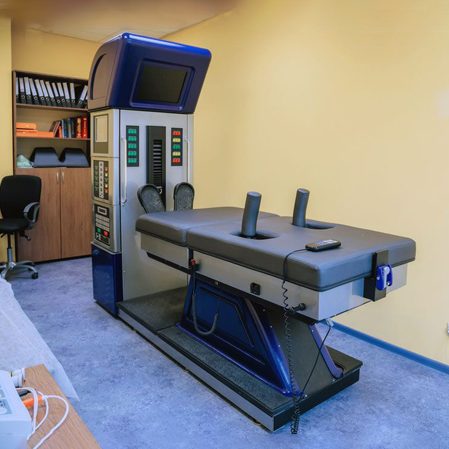Without treatment, your sciatica problem will continue to worsen. At Fort Worth chiropractic clinic, we want to inform you about sciatica and your treatment options.
Sciatica in Fort Worth
Sciatica is a symptom and not a condition. Before your discomfort can be treated, one of our Fort Worth doctors will need to diagnose the underlying cause of your sciatica. If you can, write down any other symptoms and include details about when your pain tends to flare up. Diagnosing the underlying condition involves a careful review of the patient’s medical history, a physical, and examination.
During your exam, one of our doctors may check your muscle strength and reflexes. You may be asked to walk on specific parts of your foot, such as your toes or heels. If you experience pain during these exercises, it may be a sign of sciatica. There are a variety of tests and imaging techniques that can further aid in diagnosing the cause of your pain. We may also recommend x-rays, MRI, CT scans, EMG, and nerve conduction velocity tests to confirm the diagnosis, as well.
Once our doctors understand the underlying cause of your sciatica, a thorough treatment plan can be developed. We will look at your symptoms holistically and we will never prescribe a “quick fix.”
What is the Sciatic Nerve?
The sciatic nerve is the largest in the body, traveling from the lower back through the buttocks and legs. Sciatica is a painful condition that develops when the sciatic nerve becomes irritated or inflamed. The most common symptom of sciatica is persistent sharp pain that starts in the lower back and radiates down through the hips, buttocks, and legs.
Even though the sciatic nerve runs down both legs, sciatica typically affects only one side of the body. The onset of symptoms is typically quick, and they can last for several days or weeks. Side effects can include pain that increases when sitting, a shooting pain in the thigh, or a tingling sensation in one leg.

COMMON SCIATICA SYMPTOMS
The most common symptom of sciatica is pain. Patients often link the searing pain of sciatica to electrical shocks traveling down the leg. Typically, sciatica pain only affects the lower body on one side and may feel as if it is radiating from a point in the lower back.
If you are suffering from sciatica, you may experience:
- Pain that worsens the longer you sit or stand, but feels better when you lay down or start walking
- Sharp or searing pain
- Constant pain that affects only one side of the leg or buttocks
- Shooting pain in one leg that impacts your ability to stand or walk
- Pain originating in the low back or buttock that travels down the back of the thigh and into your lower leg and foot
- Discomfort or pain in the toes
Common Causes of Sciatica
The sciatic nerve can become inflamed due to:
Discs serve as cushions between vertebra, minimizing the impact of movement on your spine. Due to age or injury, these discs can degenerate and lose their gel-like fluid, causing the outer ring of the disc to flatten. This condition can place pressure on the sciatic nerve.
As your pregnancy progresses, the uterus can begin to apply pressure to the sciatic nerve, causing discomfort.
As you age, the spinal canal begins to narrow and may press against the sciatic nerve. This condition typically affects patients 60 years of age and older.
The piriformis muscle begins in the lower back and extends through the buttocks to the upper thigh. Spasms in the piriformis muscle can irritate the sciatic nerve and lead to sciatica.
FACTORS WHICH CAN WORSEN YOUR SYMPTOMS
Patients often notice that certain actions cause their symptoms to intensify. Sudden motions, such as sneezing or coughing, and changing positions can also cause more severe pain. You could be unknowingly worsening your sciatica pain by:
- Using Improper Posture: Slumping instead of standing or sitting up straight could be aggravating your sciatic nerve.
- Stomach Sleeping: Laying on your stomach actually strains your spine and neck, exacerbating sciatica issues. Sleep on your left side or on your back with a pillow under your knees.
- Lifting With Your Back: When lifting heavy objects, it is important to use your legs since the extra stress on your back can pull or stretch sciatic nerves improperly.
- High-Impact Sports: From football to simply exercising the wrong way, you can seriously strain your spine during athletic activities.
- Wearing High Heels: If your heels measure more than an inch and a half, they transfer your body weight forward, throwing your spine out of alignment.
- Insufficient Core Strength can also exacerbate sciatica issues. Try crunches or leg presses to strengthen your core and take some of a load of supporting your body off of your spine.
Sciatica Treatment & Time Frame
Depending on the severity and location of the condition, sciatica can be a quick to long term recovery process. A common correlation is that the longer the condition had to develop, the longer it will take to correct the issue. Chiropractors' extensive schooling and experience can clear up the issue in quicker time than it took to develop.
With a low rate of success and high amounts of tries, you would think back surgery should be avoided. Back surgery has shown that only 15 percent of people are positively affected by back surgery in a 5 year time period.
At Texas Injury Clinic in Fort Worth, we are here to naturally fix your sciatica with chiropractic treatment that is intended to allow the body self-heal. Your customized treatment plan may include medication, physical rehabilitation, spinal manipulation, ultrasound, or other forms of therapy. We always strive to begin with conservative therapies. One advanced treatment we offer uses the DRX9000™, a revolutionary spinal decompression machine that provides relief for back and neck pain.

possible treatment options include
Ultrasound can reduce back pain by using vibrations to deliver energy and heat to injured areas of the back. It can also play an important role in supporting healing by promoting blood circulation.
Applying a cold pack near the source of your sciatica can reduce inflammation and pain. While ice packs should not be used for more than 20 minutes at a time, daily use of cold therapy can alleviate discomfort caused by sciatica.
For some, can deliver many of the same benefits as cold therapy. We encourage our patients to try both options in order to see which treatment delivers the best results.
Transcutaneous electrical nerve stimulation or TENS uses a portable muscle stimulating machine to administer variable intensities of electrical current to targeted areas of the back. By interfering with the function of the nerve, this treatment can reduce muscle spasms and acute pain in patients.
Under the hands of one of our expert chiropractors, spinal manipulation can realign the vertebrae. Once vertebrae are restored to their proper position, patients can enjoy benefits like decreased pain, inflammation, and nerve irritability. Spinal manipulation does not cause pain.
Non-invasive physical rehabilitation can provide significant relief while increasing a patient’s mobility. Our therapist can guide patients through specialized exercises and stretching techniques that can improve comfort while reducing inflammation.
If physical rehabilitation or other non-invasive treatments do not effectively reduce sciatica symptoms, one of our doctors may recommend a trigger point injection. The treatment involves injecting a saline solution or a local anesthetic into known “trigger points” or areas of knotted muscle in order to provide relief from nerve pain.
Vertebral misalignment can put pressure on the spine and result in a pinched sciatic nerve. To realign your spine, your doctor can provide gentle chiropractic adjustments and manipulation. The number of adjustments performed will depend upon the severity of your symptoms and how quickly your body responds to treatment. As the spine is adjusted, you should notice immediate results and reduced pain.
Our massage therapist can apply advanced therapeutic techniques, focusing on trigger points and tight muscles. This process can help to alleviate pressure on the sciatic nerve.
If surgery is required to treat your sciatica, we can provide rehabilitation exercises to help restore mobility and function.

